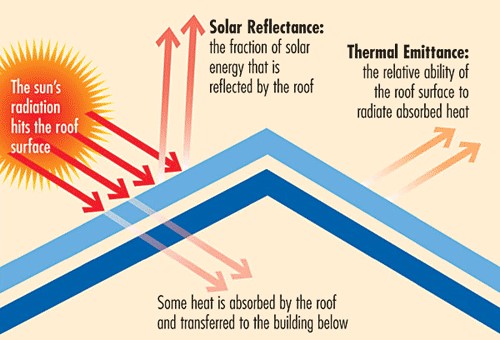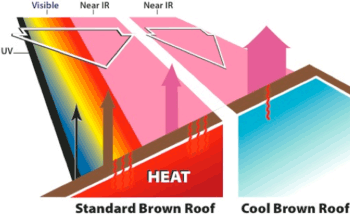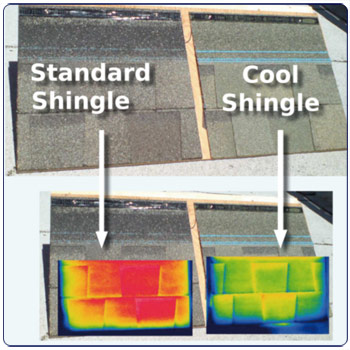Science of Cool Roofs
How do cool roofs work?
To understand how roofs can keep cool in the sun, you need to first understand solar energy. Solar energy is composed of ultraviolet (UV) rays, visible light, and infrared energy. Slightly less than half of sunlight is visible; a small fraction, less than 10%, arrives as invisible ultraviolet light, sunburns, and nearly half of sunlight arrives as invisible near infrared radiation.

Half of the sun’s energy comes in the near-infrared. You can feel it but not see it. |
The solar energy from the sun strikes a rooftop and mostly reflects back into the sky. However, some of that solar energy or radiation is absorbed as heat in the roof. Cool roofs reflect more sunlight and absorb less heat than traditional roofs. Traditional dark-colored roofing materials strongly absorb heat from sunlight, making them warm in the sun and heating the building. On the other hand, cool roofs stay cooler in the sun and transmit less heat into the building.
The "coolness" of a roof is determined by two properties of roofing materials and their combined effects on temperature:
-
Solar reflectance – ability to reflect sunlight
-
Thermal emittance – ability to cool down by emitting heat that is absorbed

Solar reflectance and thermal emittance are the two important properties of roofing materials to determine their “coolness” |
 The standard brown roof (left) reflects 10% of near-infrared sunlight (narrow pink arrow). The cool brown roof (right) looks just like the standard brown roof but reflects about 40% of near-infrared sunlight (wide pink arrow). The building under the cool brown roof requires less air conditioning to maintain comfort. |
 The left product sample shows a standard asphalt shingle and the right sample is a cool asphalt shingle. As seen in the thermal image (above), the cool asphalt shingle stays cooler in the sun than the standard asphalt shingle by reflecting the near-infrared sunlight. |
